Scottish Islands Survey 2023: main findings report
This report summarises key findings of the Scottish Islands Survey (2023), which gathered views about different aspects of island life from Scottish island residents. The results will contribute to measuring progress towards the objectives set out in the National Islands Plan (2019).
3. Main Findings
3.1 Population
Respondents to the survey included people who have always lived in their island, people who have returned, and people who moved to their island having never lived there before.
Most commonly, people move to islands for the lifestyle, work and family.
An overwhelming majority of islanders say they are likely to stay in their island for the next five years, and young islanders are more likely to stay than previously.
In the survey, we asked respondents how long they have lived in their island, why they moved to the island and how long they are likely to stay there.
Two in five respondents moved to their island having never lived there before, while one in five returned having lived elsewhere.
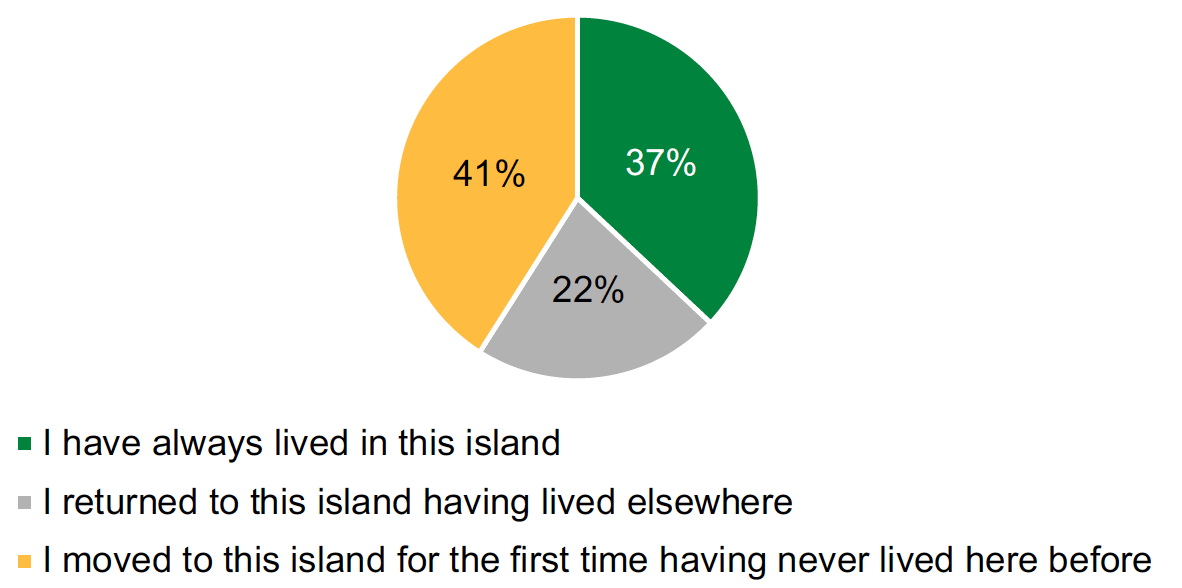
The most common reasons for moving or returning include seeking a better lifestyle or quality of life, taking up a job, and being close to family.

Most respondents (88%) say they are likely to stay in their island for the next five years.
- The proportion of movers and returners varies significantly by island region.
- 62% of respondents in Highland Islands had moved there for the first time; only 16% of Highland Islands respondents have always lived there.
- The Uists and Barra have the highest proportion of respondents who have returned (33%); Shetland Mainland and Connected Islands have the lowest (17%).
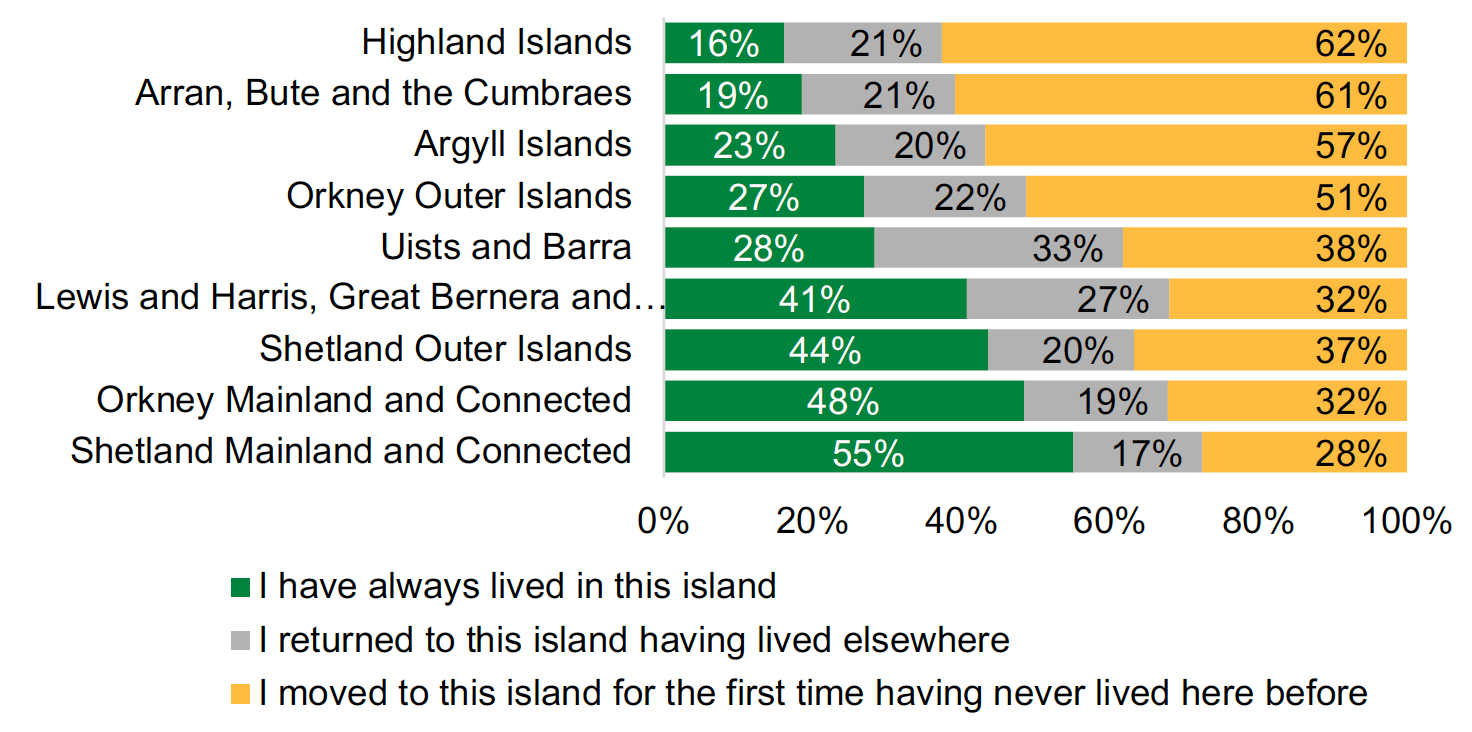
- Reasons for moving or returning vary significantly by age group and gender.
- Proximity to family is most often given as the reason for moving by younger respondents (38% of those aged 18 to 35), compared to 24% of those aged 66 and over.
- Taking up a job is a relatively common reason for moving for respondents aged 36 to 50 (39%) and 18 to 35 (36%).
- Women are more likely than men to move to be close to family (30% compared to 24%) or to be close to their partner (15% compared to 8%).
- A better lifestyle or quality of life is a common reason for moving, but slightly more so for men (47%) than women (41%).
- Men are also more likely than women to move to take up a job (35% compared with 29%) and move to retire (19% compared to 13%).
“My partner and I were able to move to the island [was] because my partner's company provided accommodation.” Female, 18 to 35, Argyll Islands
- Intention to stay for the next five years increases with age, with people aged 66 and over significantly more likely to say they will stay than people aged 18 to 35 (92% compared to 79%).
| Compared to: | |
|---|---|
| 2020 | The proportion of 18 to 35-year-old respondents think they are likely to stay in their island for the next five years has increased; from 71% in 2020 to 79% in 2023. |
3.2 Sustainable economic development
Working in more than one paid job is on the increase and more common than in the Scotland as whole.
The majority of business owners have growing businesses, but more local business support is desired.
Accessing early learning and childcare services is difficult for islanders.
The majority of islanders feel that tourism has a positive impact.
Variation between island groups is evident.
We asked respondents about their working lives, childcare services, business support and the impact of tourism on their local area.
More than one quarter of respondents work in more than one paid job or business.[13] A similar proportion work from home for at least some of the time.
Around half of respondents who run a business agree that their business is growing. However, less than a third agree that support is available locally for new businesses to start up and only a quarter agree that ongoing support for business development is available.
Only one third of respondents agree that they have access to early learning and childcare services for pre-school children that suit their working hours and almost two in five say they cannot access a registered childminder in their local area.

Three quarters of respondents say that tourism has a positive impact, however seven in ten feel that there is not enough provision for tourists and eight in ten do not feel tourism is managed in a way that is sustainable or sensitive to the local area.
“Due to a rapid increase in Cruise liner tourism in Orkney, locals can no longer access their Historical + cultural attractions. Everything is fully booked through the season. Then most close for the winter.” Female, 51 to 65, Orkney - Mainland and Connected
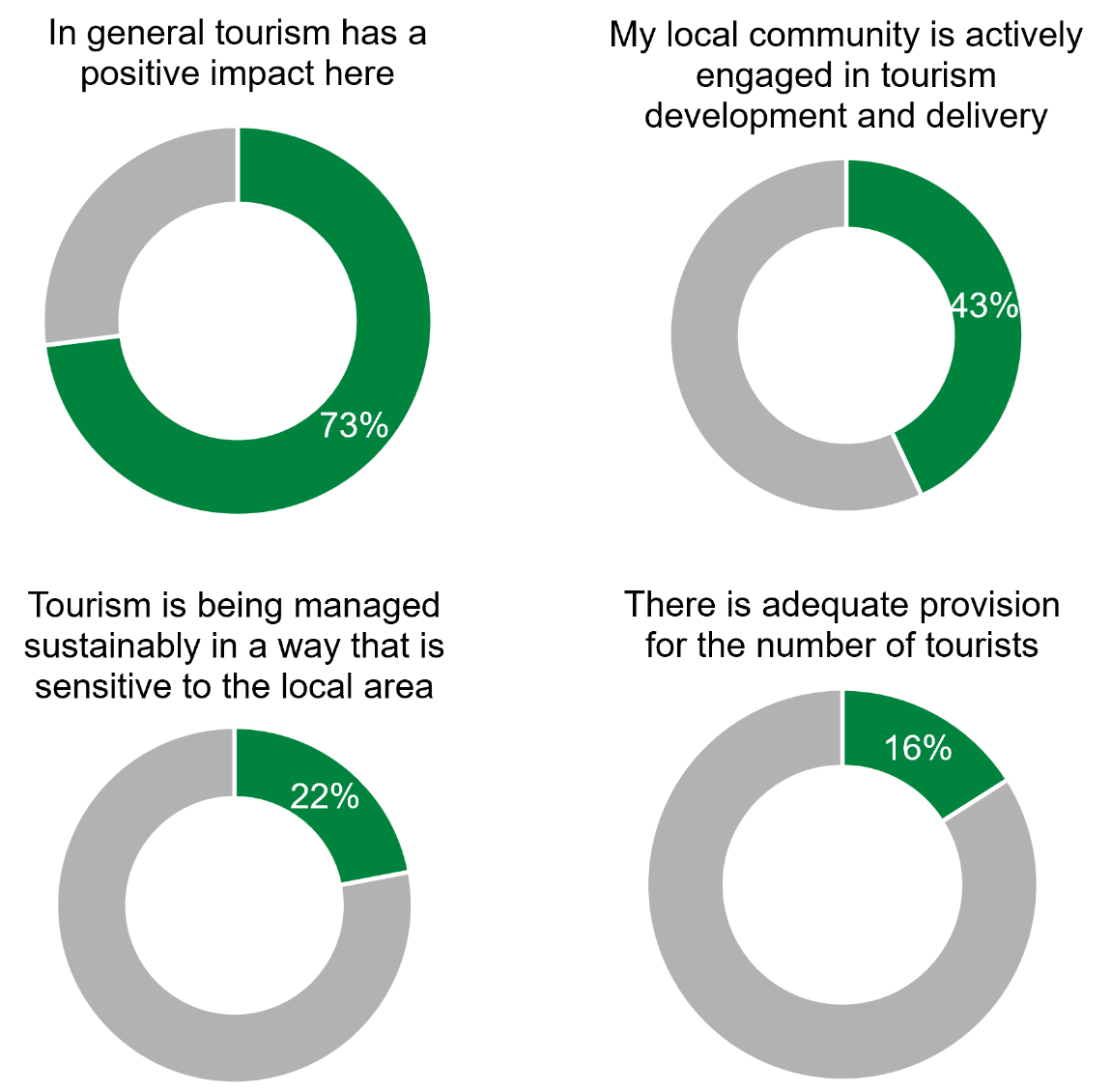
3.2.1 Job opportunities and support
- Female respondents are more than twice as likely to work part time than male respondents (19% compared to 8%) and are more likely to be looking after their home or family (7% compared to 3%). Female respondents are less likely to be self-employed or freelance (10% compared to 17%).
- The highest percentage of seasonal workers is in Highland Islands (17%) and, while there is some seasonal employment among younger cohorts, the percentage is higher among those aged 66 and over (17%).
- Respondents living in the Orkney Outer Islands and those aged 36 to 50 are most likely to work in more than one paid job or business (59% and 31% respectively).
- Highest rates of working from home are in Highland Islands (47%) and Orkney Outer Islands (42%).

3.2.2 Childcare
- While scores are low across the board for all aspects of childcare, Shetland and Orkney Mainlands and their Connected Islands report better access than elsewhere. For example, parents, caregivers or guardians of children under 16 in Shetland Mainland and Connected Islands are most likely to agree that access to early learning and childcare services for pre-school children suits their working hours (47%). Agreement is also high in Orkney Mainland and Connected Islands (37%).
- The situation is worst in the Orkney Outer Islands where no respondents report that they can access a childminder, and 7% of care-givers agree that they have access to childcare services for pre-school children that suit their working hours.
3.2.3 Business opportunities
- Respondents who run a business in Orkney and Shetland Mainlands and their Connected Islands are most likely to report that their business is growing (59% and 51% respectively) and that ongoing support for business development is available (39% and 30% respectively).
- Business owners in Orkney and Shetland Outer Isles are much less likely to report that their business is growing (34% and 21% respectively) or that ongoing support for business development is available (12% and 11% respectively).
“Almost all small businesses in my area are short staffed because they cannot afford to house employees and people can't find places to stay unless they can afford to purchase a house.” Female, 18 to 35, Argyll Islands
- Business owners in Orkney Mainland and Connected Islands (43%) and Lewis and Harris (41%) are most likely to agree that support is available for new businesses to start up. Respondents in the Highland Islands (18%), Orkney Outer Islands (19%) and Argyll Islands (20%) are least likely to agree.
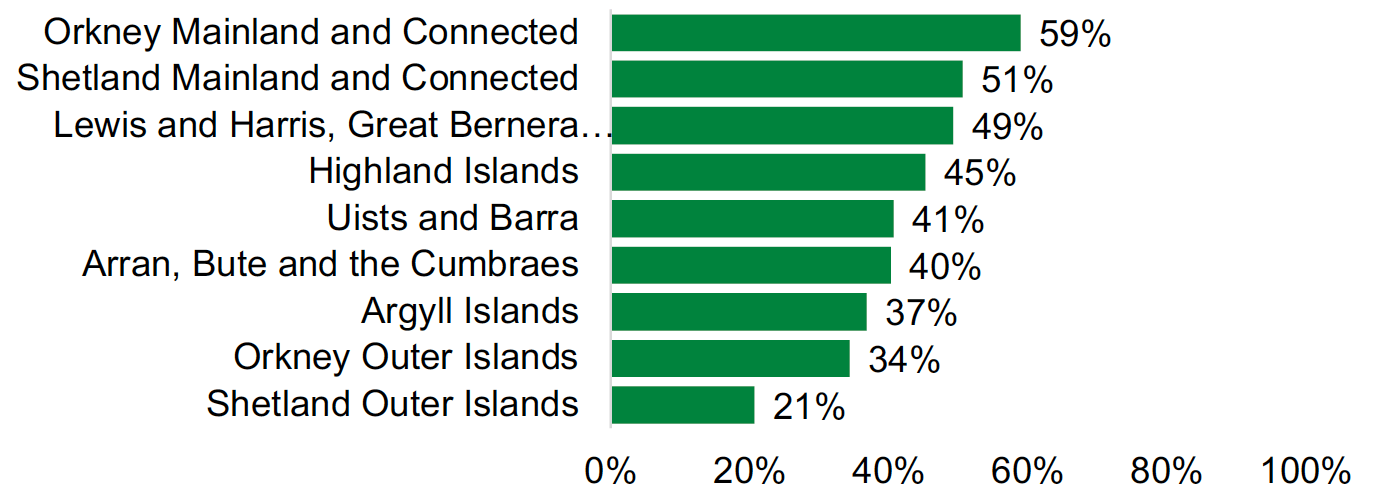
3.2.4 Tourism
- Respondents in Arran, Bute and the Cumbraes are most likely to agree that tourism is having a positive impact in the local area (81%). Respondents in Shetland Outer Islands are least likely to agree (59%).
- Respondents in Shetland Outer Islands are, however, most likely to agree that there is adequate provision for tourists, albeit just 27%. Respondents in Highland Islands and Lewis and Harris are least likely to agree (both 9%).
- Respondents in Highland Islands (73%) are most likely to disagree that tourism is managed sustainably in a way that is sensitive to the local area.
| Compared to: | |
|---|---|
| 2020 | The percentage of respondents who work in more than one paid job or business has increased, from 20% in 2020 to 28% in 2023. |
| The Highlands and Islands[14][15] | 28% of respondents to the Scottish Islands Survey 2023 work in more than one job, compared to 13% of people in the Highlands and Islands overall. |
3.3 Transport
Satisfaction with links to the Scottish mainland (both ferries and flights) has decreased since 2020, however use and perceptions of transport vary greatly.
Islanders are least satisfied with the reliability of ferries and the cost of flights.
Residents of Arran, Bute and the Cumbraes are most likely to find it easy to access essential services by public transport and Shetland Outer Islanders are least likely.
Islanders report that connecting between different forms of transport is not easy.
We asked survey respondents about their use and perceptions of public transport, including buses, ferries and planes, as well as the condition of roads, paths and pavements.
Less than half of respondents find it easy to access essential services using public transport (e.g. shop, post office, GP) and just around a quarter find it easy to connect between different forms of public transport.
Around one in five respondents say flights (to and from the mainland as well as inter-island) are reliable and fewer still find flights good value for residents. Satisfaction with ferries is slightly higher but still low: two in five respondents report that ferries are reliable and that they are good value for residents.[16]
Just over one third of respondents agree that roads, paths and pavements are in good condition.
3.3.1 Public transport
General
- Respondents in Arran, Bute and the Cumbraes (63%) and Orkney Mainland and Connected Islands (61%) are most likely to say it is easy to access essential services using public transport. Shetland Outer Islands (20%) has lowest agreement.
- Respondents in Arran, Bute and the Cumbraes (41%) and Orkney Mainland and Connected Islands (35%) are also most likely to say that connecting between different forms of public transport is easy. Lowest agreement is in Argyll Islands and the Uists and Barra (both 13%).
- Younger respondents aged 18 to 35 find it easier than other age groups to access essential services and connect between forms of public transport (57% and 32% respectively).

- Cars and other private vehicles are by far the most common modes of transport for reaching a range of services.
- Active forms of travel (e.g. cycling or walking) are most used to travel to convenience stores (29%), GPs (22%) and pharmacies (22%); 16% of respondents use active travel to get to their place of work.
- The most common uses of buses are to get to secondary schools (12%) and hospitals (11%).
Local buses
- Respondents in Arran, Bute and the Cumbraes make most use of buses, with 56% using them more than once a year. Relative to other island regions, respondents in Arran, Bute and the Cumbraes have highest satisfaction with the local bus service, with 74% saying there is usually space on the service, 71% finding it reliable and 55% saying it runs when they need it.
- Respondents in the Highland Islands are least happy with fares (25%) and Shetland Outer Islands respondents gave their local bus service the lowest scores for reliability (35%) and scheduling (23%).
Ferries to and from the Scottish mainland
- Respondents in Arran, Bute and the Cumbraes are the most frequent users of mainland ferries, with 95% travelling several times a year or more.
- Respondents in Orkney Mainland and Connected Islands and Orkney Outer Islands are most satisfied with ferries to and from the mainland (respectively, 64% and 58% of respondents find them reliable), but less than a third of respondents in Shetland Mainland and Connected Islands and Shetland Outer Islands find the fares good value for residents or say that there is usually space on the service.
Inter-island ferries
- Respondents in the Orkney Outer Islands and Shetland Outer Islands make the highest use of such services: 93% and 97% respectively use inter-island ferries more than once a year.
- Respondents in Orkney Mainland and Connected Islands and Orkney Outer Islands are most satisfied with inter-island ferries, with 65% and 71% respectively finding them reliable and 68% and 65% respectively finding the fares good value for residents.
Flights to and from the mainland
- Around half of respondents in the Uists and Barra, Lewis and Harris, Shetland Mainland and Connected Islands and Orkney Mainland and Connected Islands use flights to the mainland several times a year or more.
- Orkney Mainland and Connected Islands respondents are relatively positive about service scheduling (53%) and finding space on the service when they need it (60%), but only 18% find the service reliable.
- Just one in ten respondents from Shetland (Mainland and Connected Islands as well as Outer Islands) find the fares good value for residents. 16% of Shetland Mainland and Connected Islands respondents find the service reliable, compared to 24% of Shetland Outer Islands respondents.
- Respondents in Lewis and Harris and the Uists and Barra are more likely to say that the service is reliable, albeit the percentage is low (32%).
Inter-island flights
- Inter-island flights are most popular in Orkney Outer Islands, where a third of survey respondents fly between islands several times a year or more.
- Inter-island flights are rated significantly higher by respondents in the Orkney Outer Islands than by residents of Shetland Outer Islands on several measures. 58% of respondents in Orkney Outer Islands find inter-island flights reliable compared to 9% of respondents in Shetland Outer Islands. Similarly, 60% of Orkney Outer Islands respondents find the fares good value for residents, compared to 5% of Shetland Outer Islands respondents.
“Flight prices to and from the island are extortionate and ferries are unreliable. These are huge issues facing the island population and a decision to move away to the mainland in the near future would be spurred by continuing transport issues and costs.” Male, 36 to 50, Lewis and Harris, Great Bernera and Scalpay

3.3.2 Roads, paths and pavements
- Respondents in the Uists and Barra have lowest satisfaction with roads, paths and pavements.
- Younger people aged 18 to 35 are more positive about the condition, safety and accessibility of roads, paths and pavements. Notably, 58% of this age group agree that they are safe for walking, compared to 36% of those aged 66 and over.
| Compared to: | |
|---|---|
| 2020 | The percentage of respondents who say it is easy to access essential services using public transport has decreased, from 69% in 2020 to 47% in 2023. |
| Scotland as a whole | Use of local bus services is lower in the islands than in Scotland as a whole. 13% of islanders use the bus at least once a month compared to 37% of Scotland residents.[17] |
3.4 Housing
Most islanders are happy with their housing but say that affordable housing is not available in their area.
Satisfaction with housing availability and affordability varies between island groups and has decreased since 2020.
Young islanders are least satisfied with their current housing and availability of housing options in their area.
The survey asked respondents about their current housing and the availability of housing in their local area.
Eight in ten respondents are satisfied with their current housing. However, respondents report that the availability of housing to meet local demand, in terms of both affordability and variety, is low. Furthermore, self-build is generally not considered a viable option for home ownership.
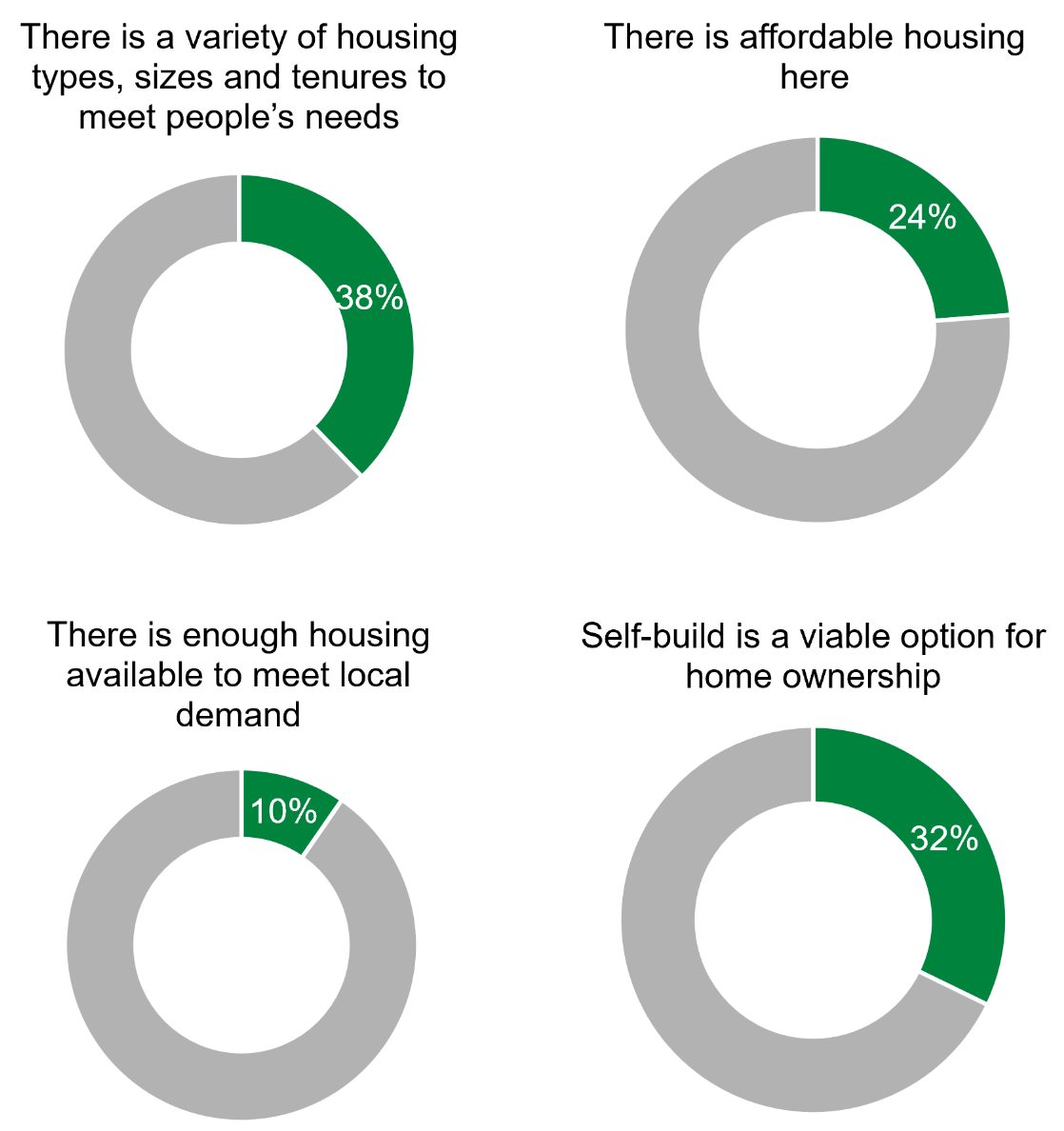
- Satisfaction with current housing varies between island regions and age groups.
- It is lowest in the Argyll Islands (66%) and highest in Arran, Bute and the Cumbraes (86%).
- Satisfaction is lowest among 18 to 35-year-olds (72%) and highest among those aged 66 and over (88%).
- Over half of respondents say that there is no affordable housing in their local area (within 3–4 miles of their home). Almost three quarters say there is not enough housing available to meet local demand.
- Satisfaction with the availability of housing is low across all island groups, with the lowest levels in the Argyll Islands, where nine out of ten respondents say there is not enough housing to meet local demand.
- Satisfaction is significantly lower among younger people aged 18 to 35. More than six in ten people in this age group disagree that there is affordable housing in their local area, and more than eight in ten say there is not enough housing to meet local demand.
“Young people cannot compete with incomes when houses come on the market. They are constantly being outbid therefore they leave the island. No affordable housing [is] available to them.” Female, 66 and over, Highland Islands
- More than a third of respondents consider that self-build is not a viable option for home ownership.
- In Highland Islands and the Argyll Islands, this rises to almost half.
- Younger people aged 18 to 35 are more likely than other age groups to believe that self-build is not a viable option (55%).
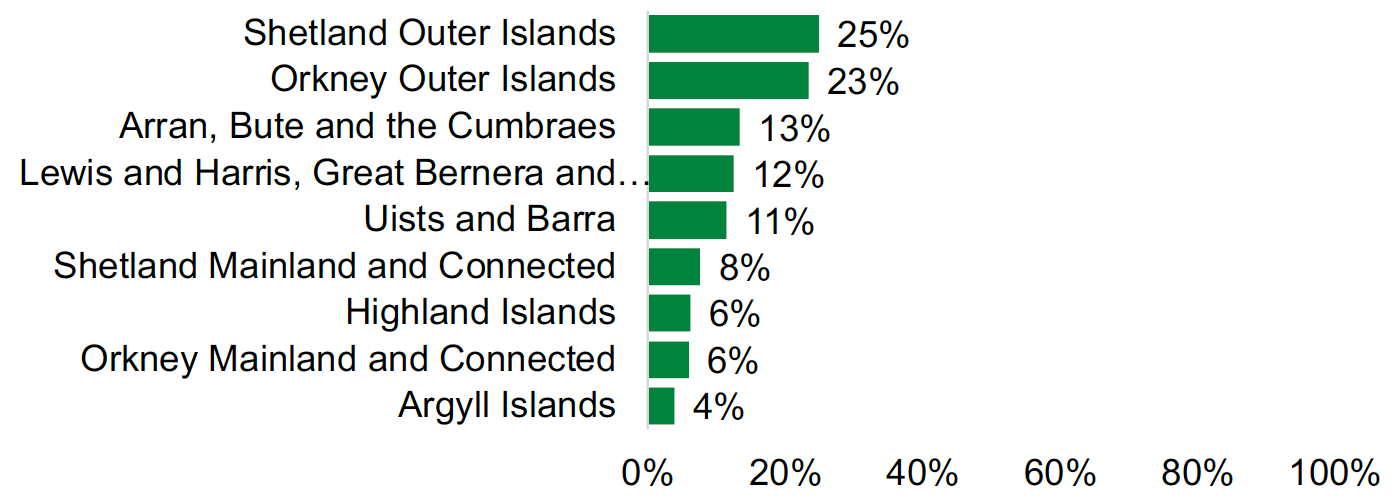
| Compared to: | |
|---|---|
| 2020 | All measures of housing availability have decreased since 2020. Just 10% respondents say there is enough housing to meet local demand in 2023, compared to 19% in 2020. |
| The Highlands and Islands[18] | 81% of islanders report being satisfied with their current housing. Across the Highlands and Islands, 90% of households say their housing situation meets their needs well. |
3.5 Fuel poverty and cost of living
Almost half of islanders say that their home sometimes feels uncomfortably cold in the winter.
The percentage of respondents who sometimes find their home uncomfortably cold in the winter has increased compared to 2020.
The percentage of respondents reporting that their household is managing well financially is lower than the percentage for Scotland as a whole.
Orkney Outer Islanders are most likely to manage very well financially, while islanders in Highland Islands and Arran, Bute and the Cumbraes are more likely to have some financial difficulties.
In the survey we asked respondents about the cost of energy and how they are managing financially.
Most respondents say that they and their household are managing very well, quite well or getting by alright financially. However, almost a quarter of respondents are concerned about paying for groceries, while one in ten is concerned about credit card repayments and paying the mortgage/rent.
Almost half of respondents say that their home sometimes feels uncomfortably cold in the winter, and around one in ten had to choose between keeping their home warm and buying food or essentials for themselves and their family in the past year. More than a third of respondents are concerned about being able to pay for heating and hot water.
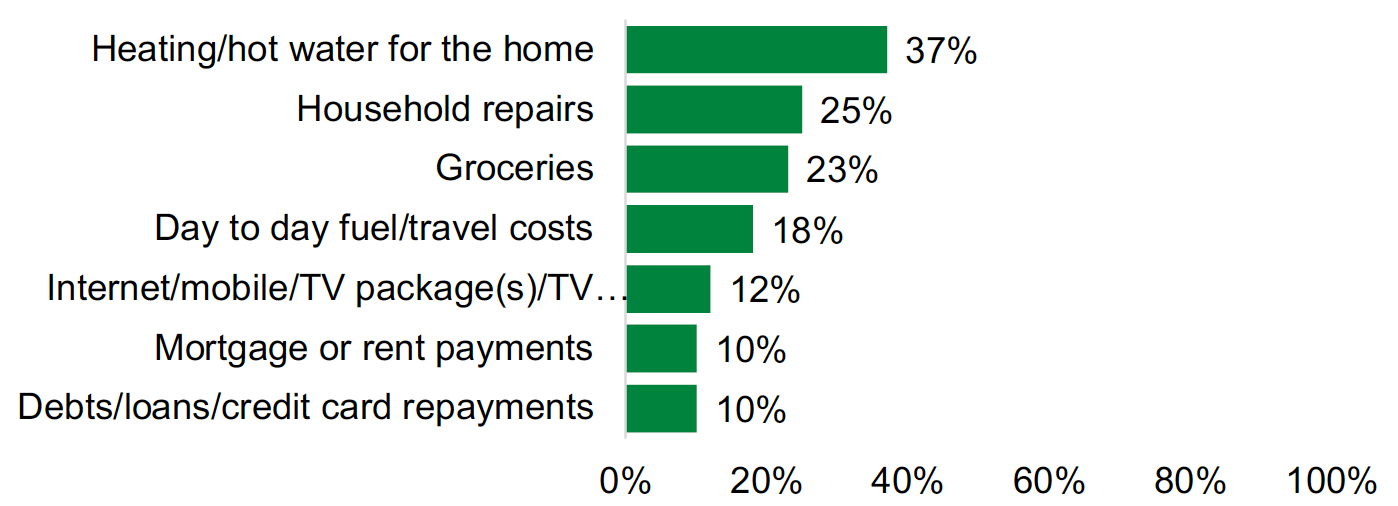
3.5.1 Cost of living
- Orkney Outer Islands have the highest percentage of respondents agreeing that they are managing very well financially (18%). Respondents in Highland Islands and Arran, Bute and the Cumbraes are most likely to agree that they are having some financial difficulties (9%).
- Residents of Arran, Bute and the Cumbraes (28%), the Uists and Barra (27%) and Argyll Islands (26%) are more concerned than other island regions about paying for groceries. Concern about affording household repairs is highest in Orkney Outer Islands (32%).
- Significantly fewer older people (aged 66 and over) express concern about paying for groceries (17%), debts/loan/credit card repayments (3%) and mortgage or rent payments (3%), compared to other age groups.
- 3% of respondents state that they have used a food bank or other food support system for themselves or their family.
- 36 to 50-year-olds are most likely to report that they had used a food support system (5%) and those aged 66 and over are least likely (2%).
3.5.2 Fuel poverty[19]
- Respondents in Orkney Outer Islands (44%) and Arran, Bute and the Cumbraes (43%) are most concerned about being able to pay for heating/hot water for the home in the next two to three months.
“The cost of living in Shetland is astronomical. Heating bills take up a disproportionate amount of earnings, electricity costs are huge.” Female, 36-50, Shetland Mainland and Connected Islands
- Younger people aged 18 to 35 are more likely to say that their home sometimes felt uncomfortably cold in the winter (52%) than those aged 66 and over (43%).
- 62% of respondents, and over 55% in every region, agree that they could afford to keep their home warm in the past year.
- Agreement rates are higher among those aged 66 and over at 64%, compared to 58% among those aged 51 to 65.
- 18% of respondents are concerned about paying for day-to-day fuel/travel costs over the next two to three months.
- Respondents living in Orkney Outer Islands are most concerned (24%).
- Concern is highest among those aged 36 to 50 (24%) and lowest among those aged 66 and over (14%).
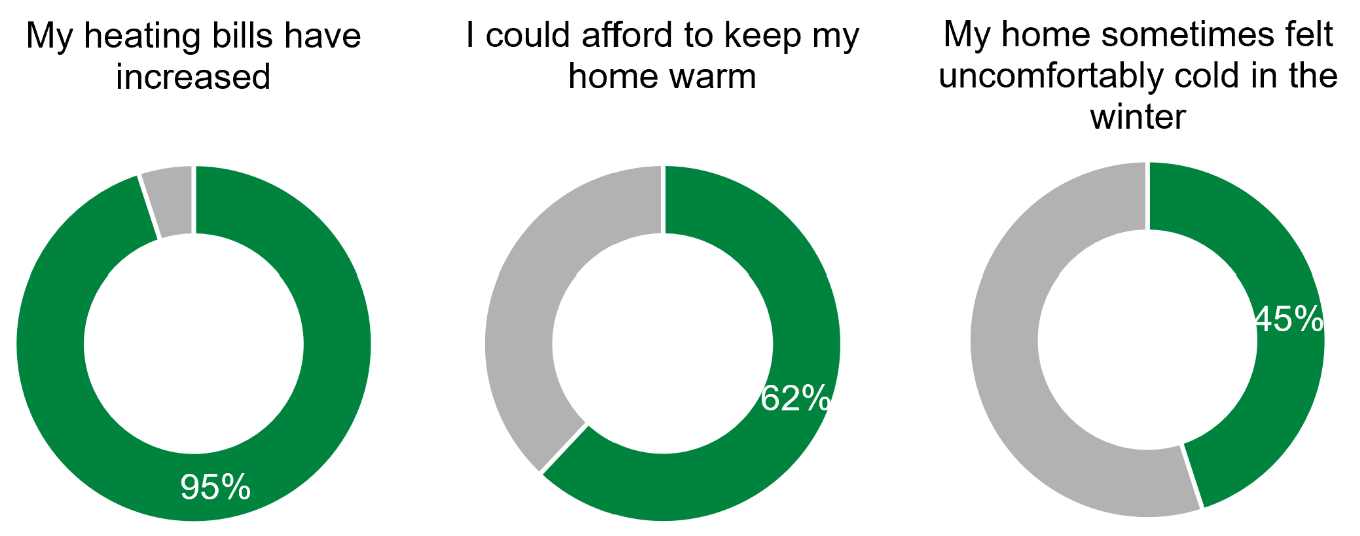
| Compared to: | |
|---|---|
| 2020 | The percentage of respondents who sometimes find their home uncomfortably cold in the winter has increased, from 35% in 2020 to 45% in 2023. |
| Whole of Scotland | The percentage of respondents reporting that their household is managing well or quite well financially is lower than the percentage for Scotland as a whole: 45% compared to 50%.[20] |
3.6 Digital connectivity
Digital connectivity varies a great deal across island groups.
More islanders are satisfied with the speed of their internet connection than in 2020.
Shetland Mainland and Connected Islanders are most satisfied with the speed of their internet connection and Shetland Outer Islanders are least satisfied.
Orkney Mainland and Connected Islanders are much happier with their mobile coverage than Orkney Outer Islanders.
The majority of respondents – particularly older respondents – think it is important to have an active landline.
In the survey we asked respondents about their internet and mobile connections.
Two thirds respondents agree that their internet connection at home is fast enough to do what they (and their household) want online and that their internet connection is reliable. Half agree that their internet connection is good enough to allow them (and their household) to work from home.
Just over half of respondents agree that there is a good mobile phone signal in their local area, and 60% have a good signal at home.
The majority of respondents think it is important to have an active landline.
- Digital connectivity varies a great deal across the island regions. 73% of residents of Shetland Mainland and Connected Islands are satisfied with their internet speed, compared to 43% in Shetland Outer Islands. Respondents in Shetland Outer Islands are also least likely to report that their internet connection is reliable (34%).
“A reliable fast internet service would make life a lot easier – I used to work from home but the lack of reliability made that more difficult and stressful than it was worth. The intention of BT to remove landlines is a worry on an island that experiences frequent supply disruptions.” Female, 51 to 65, Shetland Outer Islands
- Mobile coverage is also uneven. 68% of respondents in Orkney Mainland and Connected Islands agree that they have a good mobile phone signal in their home, compared to 49% in Orkney Outer Islands. A similar difference is noted between the two island regions with respect to mobile phone signals in the local area.
- Agreement that it is important to have an active landline increases with age, from 31% of those aged 18 to 35 to 84% of those aged 66 and over. Agreement is 60% or higher in all island regions except Arran, Bute and the Cumbraes (51%) and the Argyll Islands (54%).
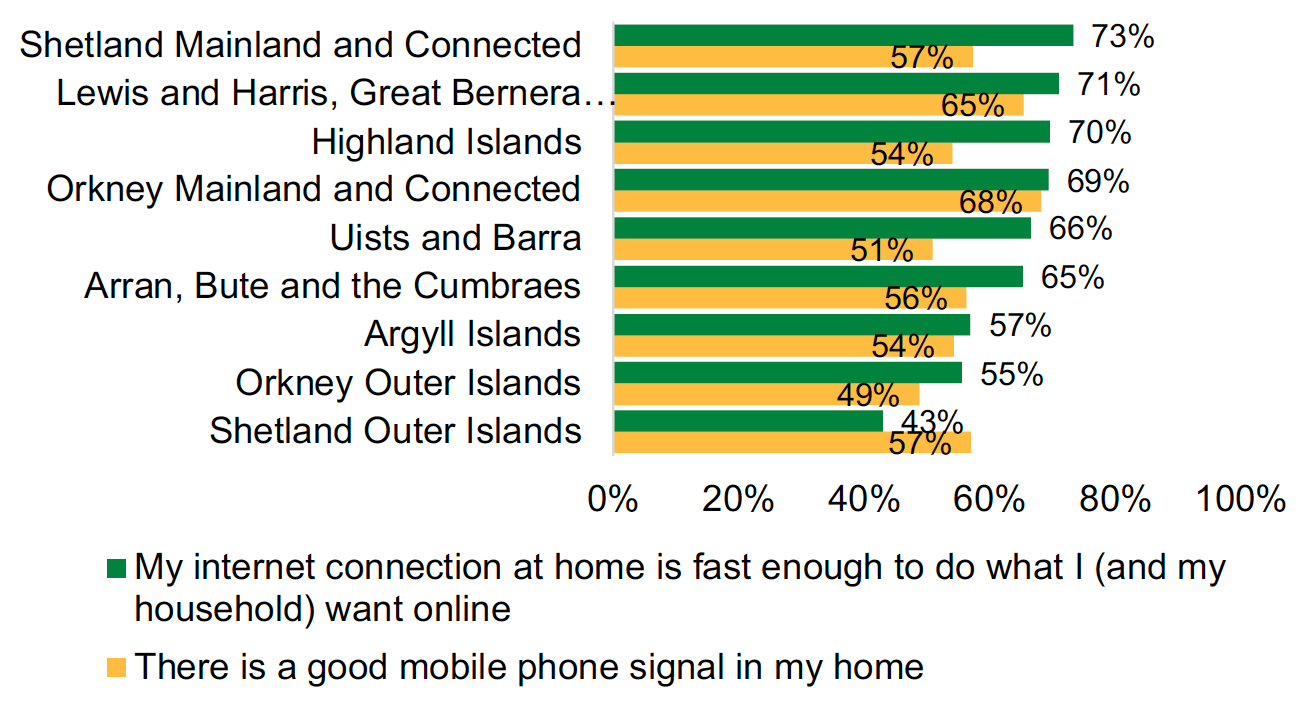
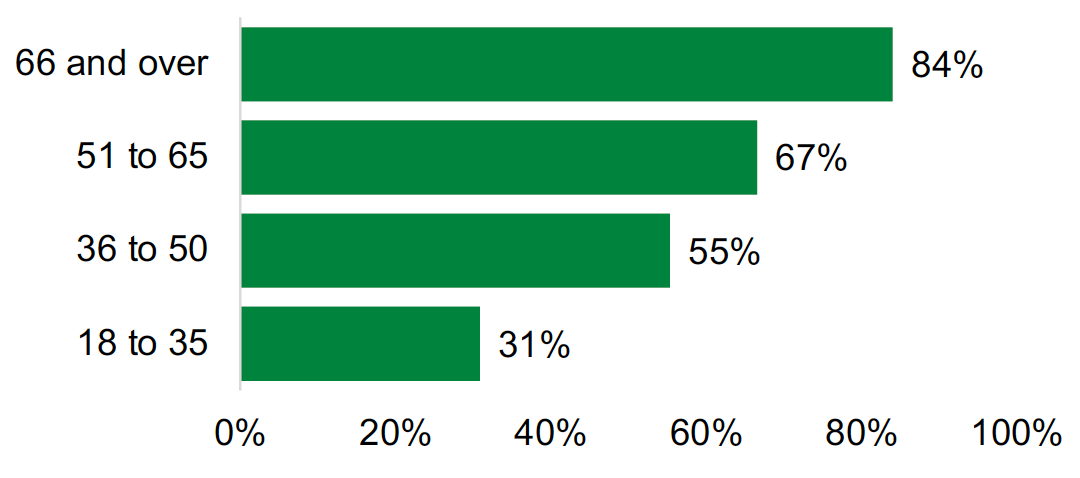
| Compared to: | |
|---|---|
| 2020 | The percentage of respondents whose internet connection at home is fast enough to do what they (and their household) want online has increased, from 65% in 2020 to 68% in 2023. |
| Whole of Scotland | The percentage of islanders reporting that they have access to the internet from home (90%) is similar to the percentage for Scotland as a whole (91%).[21] |
3.7 Health, social care and wellbeing
Older islanders are more likely to have long-term health conditions but better mental wellbeing.
Most islanders have access to sports and exercise facilities but do not always find them affordable, and fewer respondents find them affordable than in 2020.
The majority of islanders have access to a wide range of fruit and vegetables and over 90% of Orkney Mainland and Connected Islanders have access to locally produced food and drink.
We asked respondents about their physical and mental health, physical activity and access to food and drink.
Around one third of respondents report having a physical or mental health condition. A similar proportion report that a member of their household provides regular support for someone with a long-term disability or problems related to old age.
Four in five respondents agree that they have access to places where they can take part in sports and exercise. Three in five say that such facilities are good quality. Less than half agree that they are affordable.
Almost nine in ten respondents say they have access to a wide range of fruit and vegetables and six in ten agree that it is easy to buy locally produced food and drink. However, just over half agree that fruit and vegetables are affordable.
3.7.1 Physical and mental health
- Almost half (46%) of older respondents reported having a physical or mental health condition or illness.
- Mental wellbeing scores are lower for younger respondents aged 18-35 (22) than older respondents (23).[22]. This mirrors the pattern in Scotland as a whole where in 2022, older adults reported higher WEMWBS scores compared to younger adults[23].
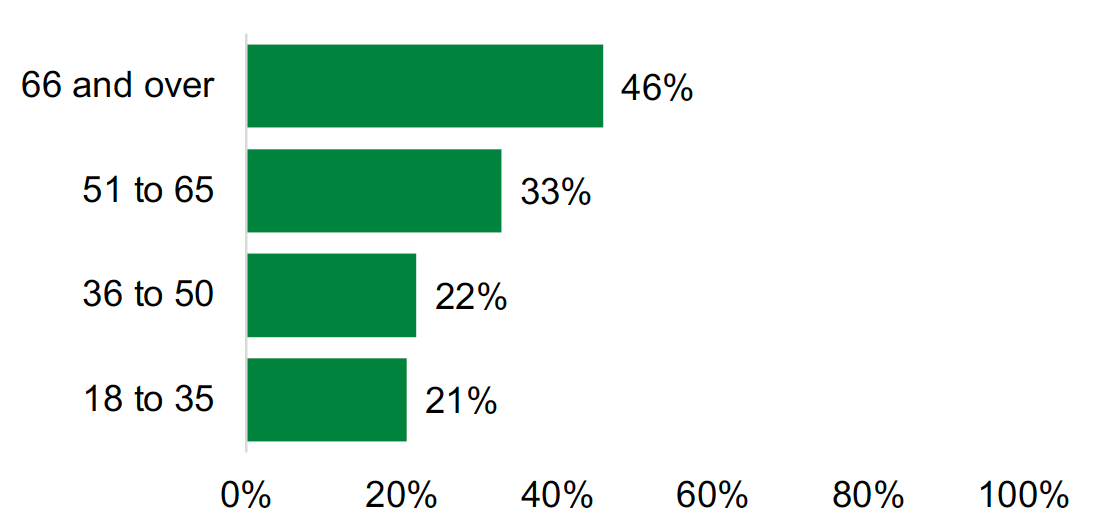
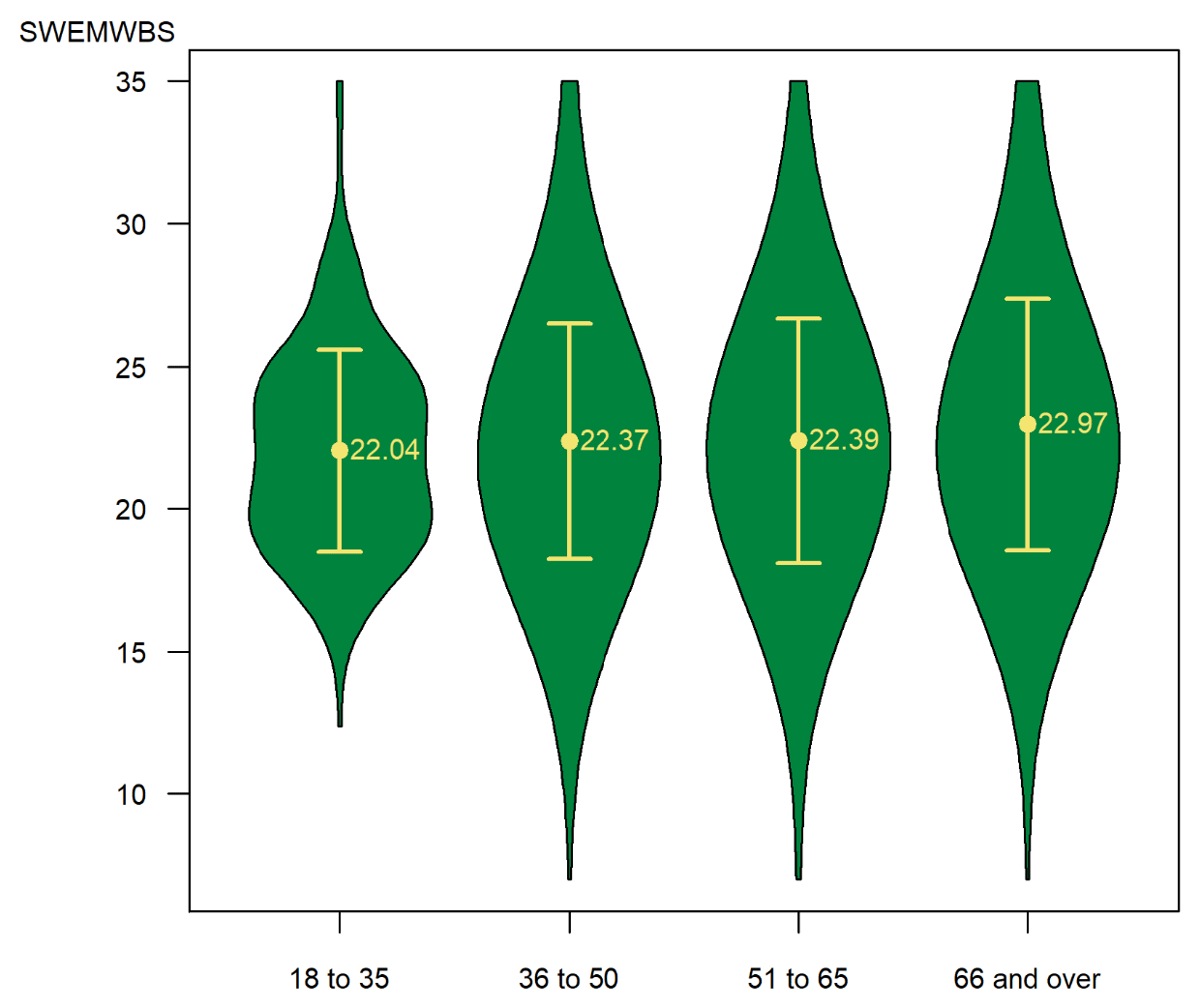
3.7.2 Physical activity in islands communities
- Younger respondents (aged 18 to 35) are more likely to report that they have access to places where they can take part in sports and exercise (93%).
- Respondents in the Argyll Islands are least likely to agree that they have access to sports and exercise facilities (54%), that such facilities are good quality (26%) and that they are affordable (21%).
- Lewis and Harris (59%), Shetland Mainland and Connected Islands (56%) and Orkney Mainland and Connected Islands (53%) have the highest levels of agreement that sports facilities are affordable, and also score highly for other measures of sports facilities.
“On a positive note the sports facilities are fantastic and need to be protected.” Male, 18 to 35, Shetland Mainland and Connected Islands

3.7.3 Food and drink
- Respondents in Orkney Mainland and Connected Islands (95%) and Shetland Mainland and Connected Islands (90%) are most likely to indicate that they have access to a wide range of fruit and vegetables. The island region with the lowest level of agreement is the Argyll Islands (71%).
- 91% of respondents in Orkney Mainland and Connected Islands say that it is easy to buy locally produced food and drink, followed by 75% of respondents in Shetland Mainland and Connected Islands. Lowest agreement is found in the Uists and Barra (35%) and Highland Islands (38%).
- Younger respondents (18–35) are more likely to agree that it is easy to buy locally produced food and drink than other age groups (76%).
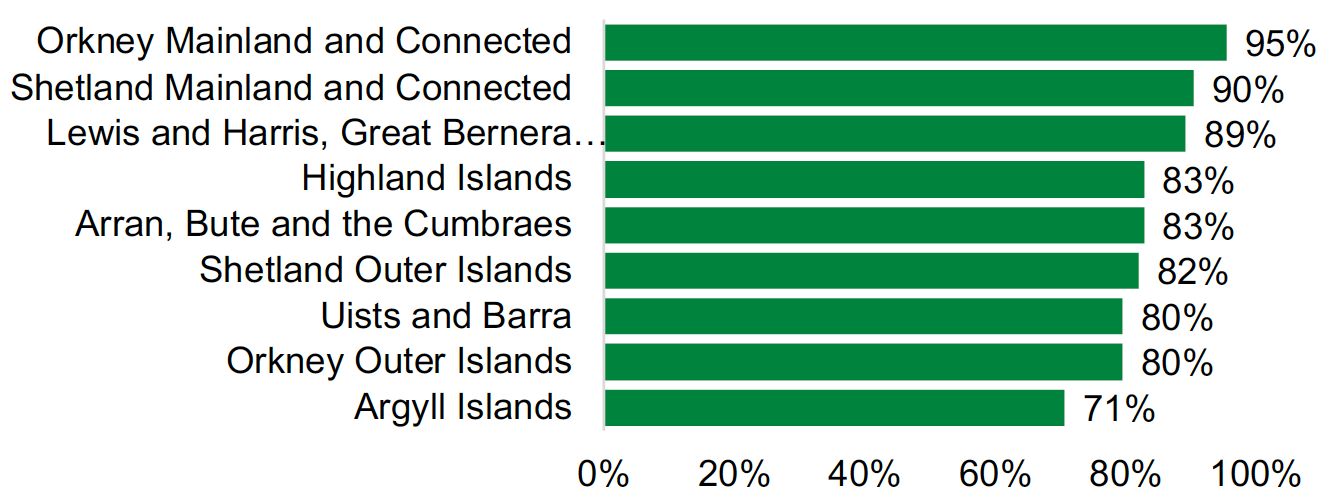
| Compared to: | |
|---|---|
| 2020 | The percentage of respondents who say sports facilities are affordable has fallen, from 59% in 2020 to 47% in 2023. |
| Whole of Scotland | The mean mental wellbeing score is slightly lower in the islands than in Scotland as a whole: 22.5 compared to 23.8.[24] |
3.8 Environmental wellbeing and climate change
The vast majority of islanders, and more than in Scotland as a whole, have a green or blue outdoor space within a 5-minute walk of their home.
Almost half of all respondents have installed additional home insulation and more than one in ten have installed a heat pump.
Home energy improvements are most common among respondents in Orkney.
We asked respondents about their local environment and their home energy, including use of renewables.
Islanders are generally very positive about their local environment and find it easy to recycle waste but litter is a problem in some island regions and it is not always easy to dispose of bulky items.
“Generally, living in an island has been a very positive experience; I (and my family) enjoy the wide spaces, wildlife and low crime.” Female, 51 to 65, Orkney Outer Islands
Almost half of all respondents have installed additional home insulation and 14% have installed a heat pump. One in ten respondents say they are likely to change to a renewable energy source for their home in the next two to three years. The most common reasons for not doing so are cost and insufficient financial support.
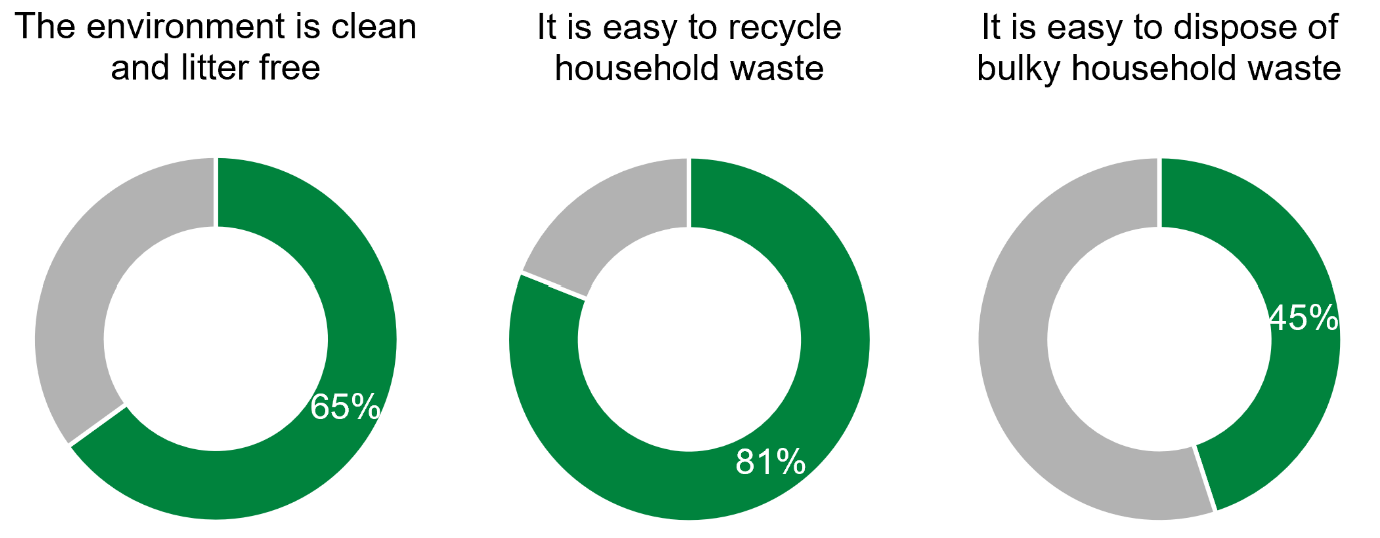
3.8.1 Local environment
- Respondents in Shetland Outer Islands are most likely to report that their local area is clean and litter free (73%) and respondents in Arran, Bute and the Cumbraes are the least likely (53%).
- Orkney Outer Islands and Shetland Outer Islands respondents are least likely to agree that it is easy to dispose of bulky household items (19% and 22% respectively), and respondents in Orkney Outer Islands are least likely to agree that it is easy to recycle household waste (40% compared to 81% overall).
3.8.2 Home energy
- Changes to home energy are most common among Orkney respondents: In Orkney Outer Islands, 63% of respondents have installed additional home insulation and 22% have installed a heat pump; in Orkney Mainland and Connected Islands, the percentages are 51% and 24% respectively.
- Intentions to change to renewable energy vary by island region. 20% of respondents in Orkney Outer Islands are likely to change compared to 5% in Arran, Bute and the Cumbraes.
- Respondents in Lewis and Harris are most likely to say that it is too expensive to change (52%), or that there is not enough financial support (32%). Respondents in Arran, Bute and the Cumbraes are most likely to report that their home isn't suitable (22%), or they are unsure how to change (21%).
- Respondents aged 66 and over are less likely to change to a renewable energy source (7%) than younger respondents (10%). This age group is also more likely to say that there is not enough financial support to change (32%), they don't want to change (28%), or that it’s too much hassle (27%). Younger people are most likely to give not owning a home as the reason for not changing (26%).
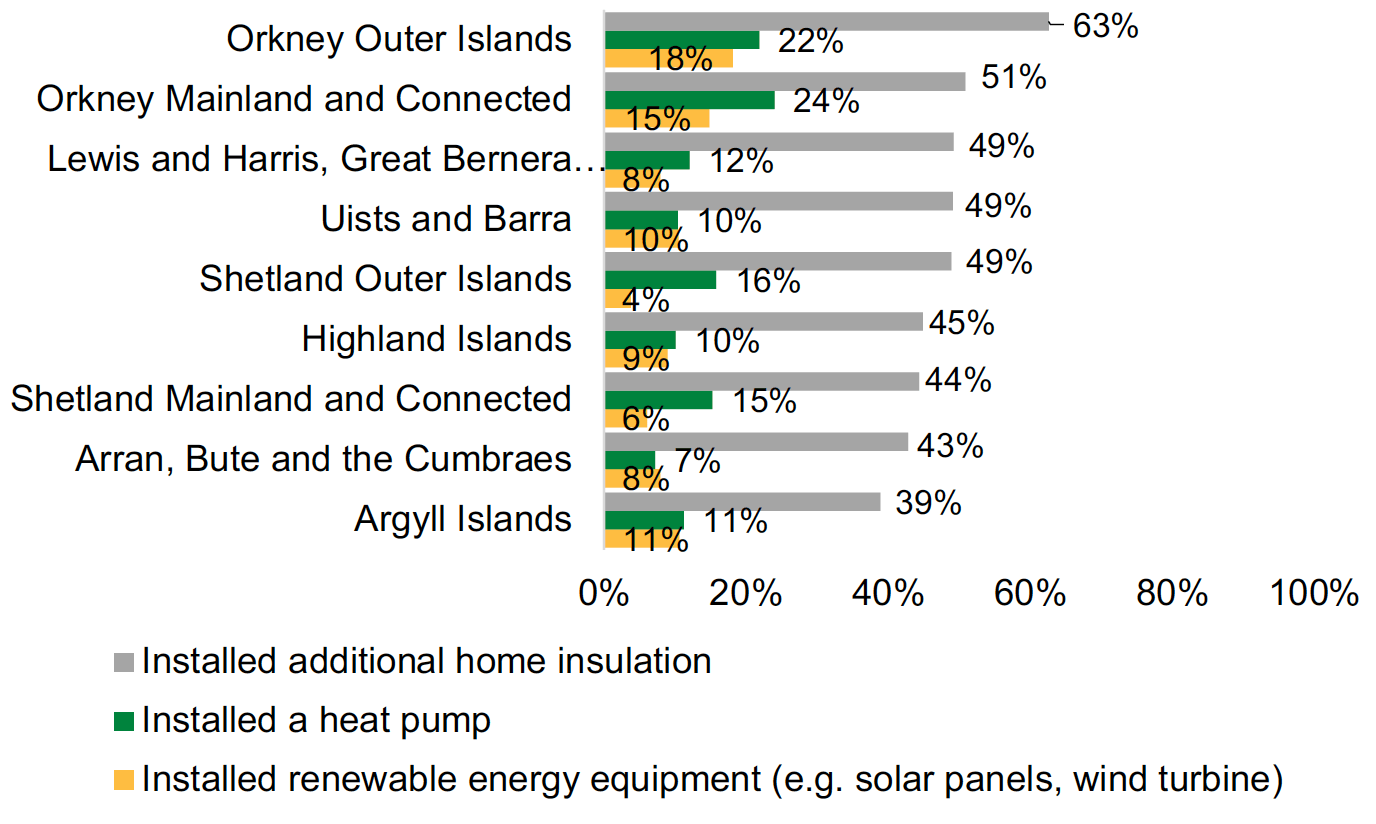
| Compared to: | |
|---|---|
| 2020 | The percentage of respondents who agree that it is easy to dispose of bulky household waste has decreased, from 48% in 2020 to 45% in 2023. |
| Whole of Scotland | 91% of islanders have a green or blue outdoor space within a 5-minute walk of their home, compared to 70% of people across Scotland as a whole.[25] |
3.9 Empowering communities
Islanders generally have a strong sense of belonging to their local community, although this varies across the island groups and has decreased since 2020.
Sense of community is especially strong in Shetland Outer Islands.
Islanders, particularly young islanders, feel more empowered when it comes to influencing the decisions made by community organisations compared to national and regional organisations such as local authorities.
We asked respondents about their sense of belonging, the sense of community in their local area, and their influence over a range of organisations.
Seven in ten respondents see themselves as belonging to their local community, and six in ten say there is a strong sense of community in their local area.
Some respondents suggested an increase in tourism had an impact on the community and a sense of belonging:
“My main concern is the very high numbers of tourists visiting the Islands with the increase in cruise ship visits. These are affecting local quality of life and sense of belonging to our own Isles. It is also being detrimental to our natural cultural heritage.” Female, 51 to 65, Shetland Mainland and Connected
Respondents feel more empowered when it comes to influencing community organisations (such as community councils, development trusts and community groups) than national and regional organisations (such as local authorities and health boards). Just 6% feel they have influence over decisions made by the Scottish Government and 10% feel they can influence their local authority, while almost a third feel they can influence their community council and other community organisations.

- Sense of belonging is highest in Orkney Outer Islands (82% agree) and lowest in Shetland Mainland and Connected Islands (63% agree). It also increases with age: 67% of younger people agree that they belong to their local community, compared to 77% of older people.
- Sense of community is highest in Shetland Outer Islands (79% agree) and lowest in Shetland Mainland and Connected Islands (58% agree) and Highland Islands (57%).
“We have quite a few holiday homes in our area. I feel this has weakened the community to an extent.” Male, 66 and over, Orkney Mainland and Connected Islands
- Perception of influence over community organisations is particularly high in Orkney Outer Islands (41%), Highland Islands (44%) and Shetland Outer Islands (37%). Respondents in Arran, Bute and the Cumbraes are the least likely to feel they have influence over decision making in their community (24%).
- Younger people aged 18 to 35 are more likely to feel that they have influence over decisions made by community organisations (38%) than those aged 66 and over (20%).

| Compared to: | |
|---|---|
| 2020 | The percentage of respondents who feel there is a sense of community in their local area has decreased, from 69% in 2020 to 62% in 2023. |
| Whole of Scotland | 71% of islanders feel a sense of belonging to their local area, compared to 83% of people across Scotland.[26] |
3.10 Arts, culture and language
Attendance at community social events has increased.
Considerably more islanders attend culturally specific festivals than residents of Scotland as a whole.
Around half of respondents in na h-Eileanan Siar can speak Gaelic and a higher proportion can understand it.
Orkney and Shetland dialects are spoken more widely among younger islanders than older islanders, and almost three quarters of Shetland Mainland and Connected Islands residents can speak Shetland dialect.
In the survey, we asked respondents about their participation in a range of social and cultural activities and their use of indigenous languages.
Respondents participate in a range of social and cultural activities, most commonly going to a pub, bar or club, attending community social events, visiting historic places and attending culturally specific festivals.
Around half of respondents in Orkney and Shetland (Mainland and Connected as well as Outer Islands) can speak the local dialect.
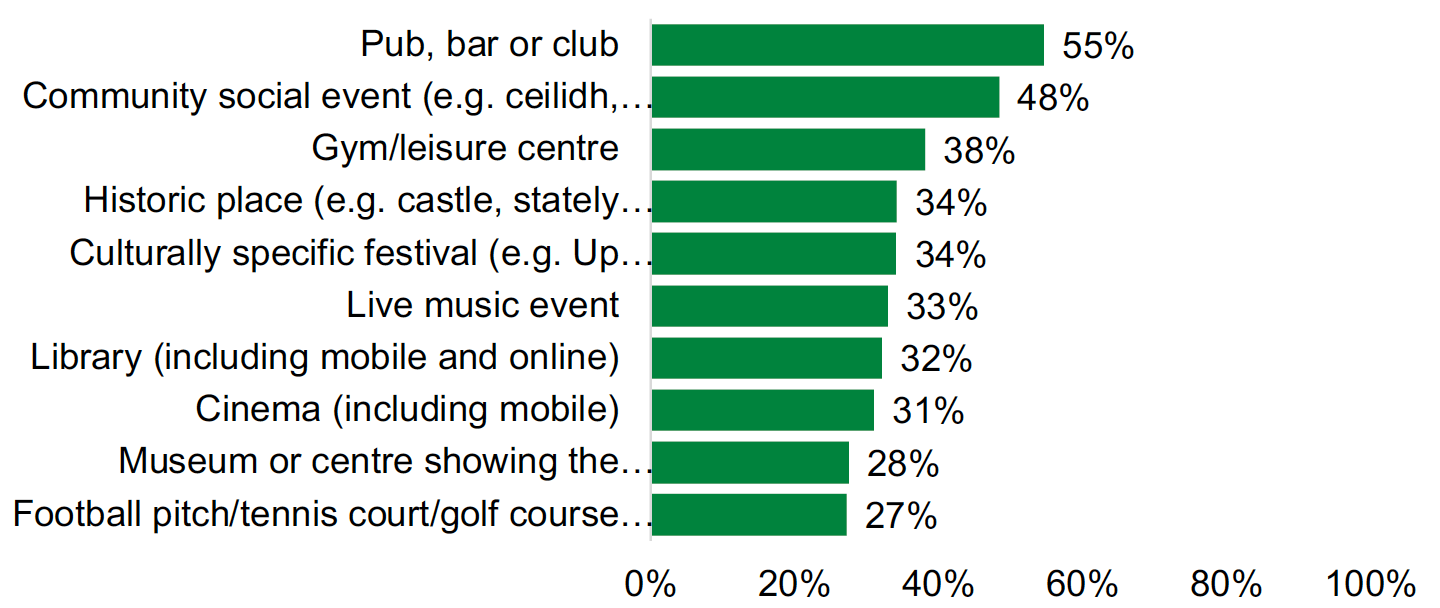
* Several times a year or more
3.10.1 Social and cultural participation
- 71% of Orkney Outer Island respondents attend community social events several times a year or more, compared to 41% of Orkney Mainland and Connected Islands residents, and 36% of Arran, Bute and the Cumbraes.
- Shetland Mainland and Connected Islands residents are most likely to attend culturally specific events (52% attend several times a year or more).
- Social and cultural participation is generally lower among those aged 66 and over. Younger people aged 18 to 35 more frequently go to pubs, bars or clubs (69%), go to the gym (62%), attend culturally specific festivals (48%), visit historic places (45%) and attend live music events (39%).
“The pandemic and lockdown have had an adverse effect on life here. Several weekly events no longer happen - no whist drives, no quiz nights, no badminton. (An aging village population doesn't help.).” Female, 66 and over, Arran, Bute and the Cumbraes
3.10.2 Scotland’s indigenous languages
- The highest proportions of Scottish Gaelic speakers are in the Uists and Barra (55%), Lewis and Harris (46%), Highland Islands (25%) and Argyll Islands (13%).
- The proportions able to understand Gaelic are higher: 67% in the Uists and Barra, 58% in Lewis and Harris, 37% in Highland Islands and 23% in Argyll Islands.
- Ability to read Gaelic is somewhat lower (40% in the Uists and Barra, 36% in Lewis and Harris, 18% in Highland Islands and 12% in Argyll Islands).
- No difference in Gaelic language use is observed across age groups.
- The highest proportions of speakers of local dialect are in Shetland Mainland and Connected Islands (73%), Shetland Outer Islands (70%), Orkney Mainland and Connected Islands (64%) and Orkney Outer Islands (49%).
- The proportion of island residents who speak a local dialect decreases with age: 46% of respondents aged 18 to 35 compared to 26% of those aged 66 and over.
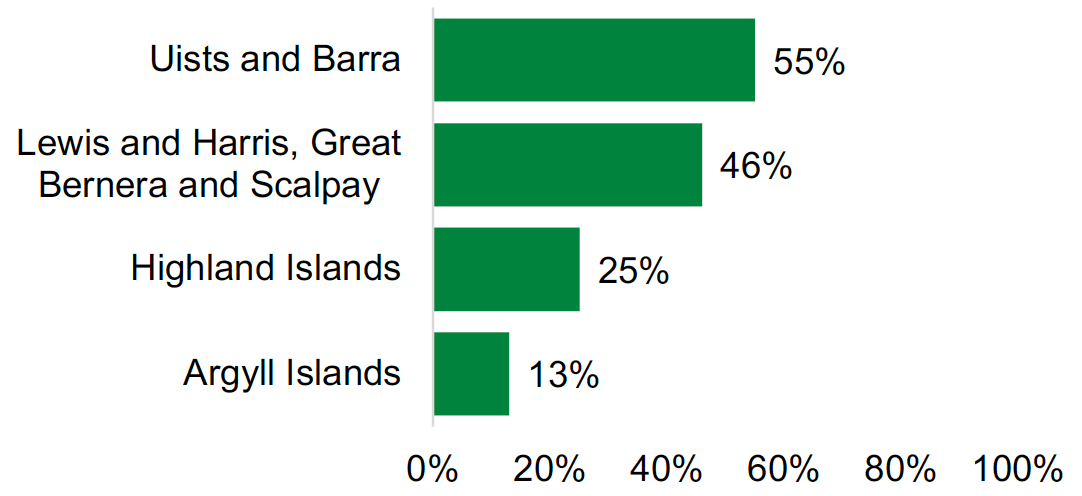
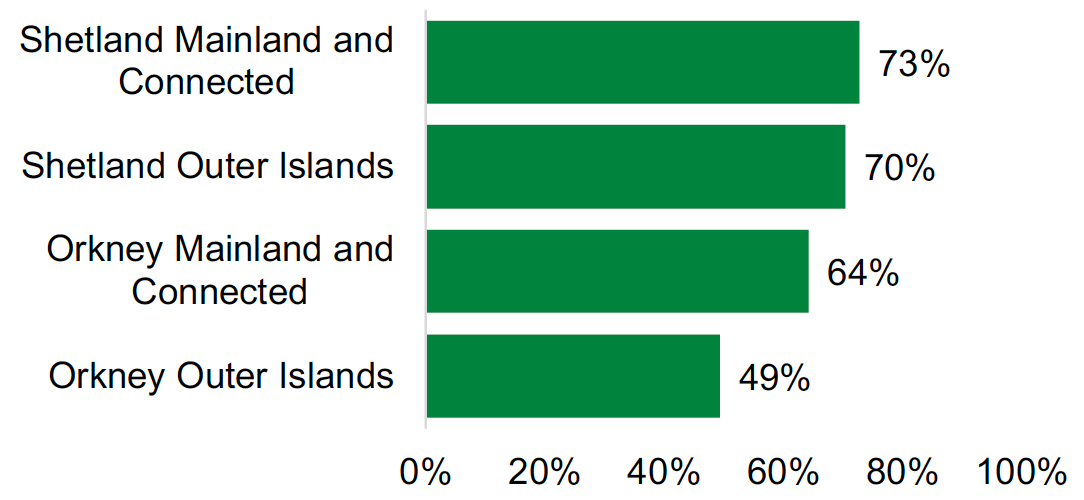
| Compared to: | |
|---|---|
| 2020 | The percentage of respondents who say that they go to community social events at least once a year has increased, from 46% in 2020 to 64% in 2023. |
| Whole of Scotland | 65% of islanders have attended a culturally specific festival in the past 12 months. In contrast, 5% of people across Scotland have attended a cultural event in the same period.[27] |
3.11 Education
Perceptions of access to education vary between island groups.
Parents and care-givers in Shetland Mainland and Connected Islands are most likely to report that children have access to good quality primary and secondary education; parents and care-givers in Uists and Barra are least likely.
Perceptions of access to college and university education also vary by region, with islanders in Orkney Mainland and Connected Islands and Lewis and Harris most positive and Shetland Outer Islanders least positive.
Fewer islanders say they could do a university degree in a subject of their choice while living in their island compared to 2020.
We asked respondents who are parents, care-givers or guardians of children under 16 about access to primary and secondary education, and all respondents about access to college, university and training opportunities.
Three quarters of respondents who are parents, care-givers or guardians agree that children have access to quality primary school education. This figure drops to three in five with respect to secondary education.
Three in five respondents perceive they could complete a college education in a subject of their choice while living in their island, compared to two in five with respect to completing a university degree.
- Over 80% of respondents in the Northern Isles who are parents, care-givers or guardians feel that children have access to quality primary education. The Uists and Barra and Argyll Islands have lower levels of agreement (59% and 61% respectively).
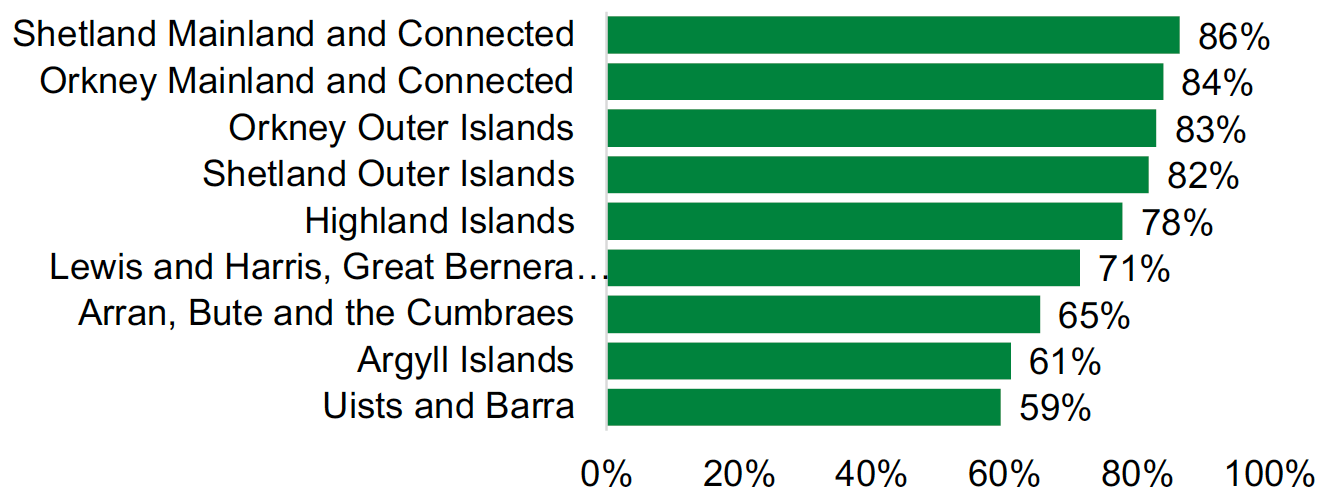
- Agreement in the Northern Isles is also high with respect to secondary education, at over 70%, except for Orkney Outer Isles where agreement drops to 46%. Low agreement is also found in the Uists and Barra (36%), and in Arran, Bute and the Cumbraes (44%).
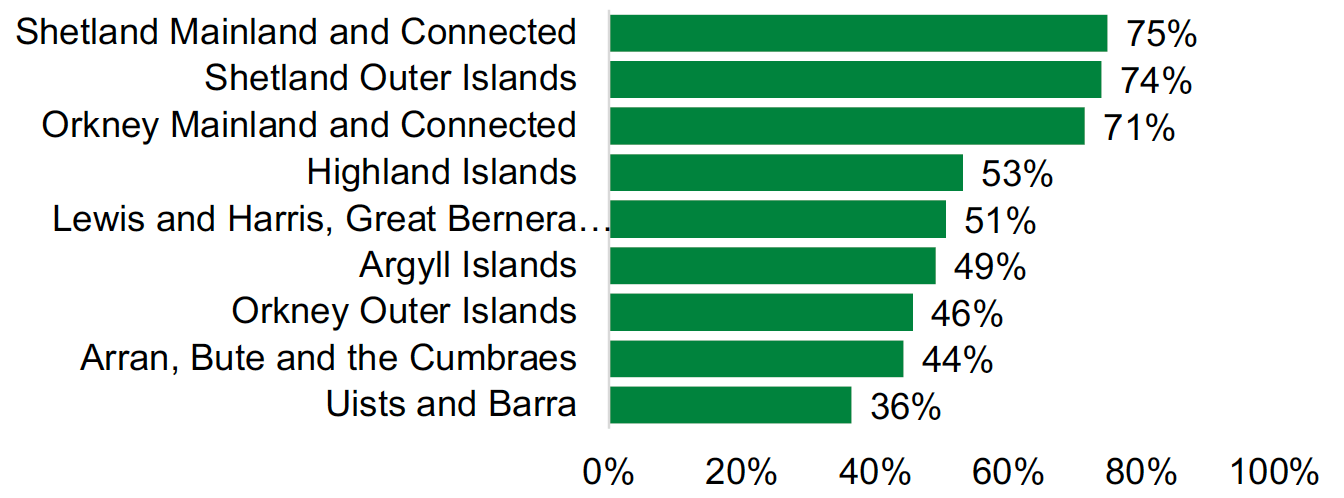
- Younger islanders (aged 18 to 36) are more likely to agree that they could complete a college education while living in their island than older islanders (aged 66 and over): 74% compared to 50%.
- Highest levels of agreement are found in Orkney Mainland and Connected Islands (73%), the Isle of Lewis and Harris (71%), and Shetland Mainland and Connected Islands (69%). Arran, Bute and the Cumbraes (44%) and the Shetland Outer islands (45%) have the lowest levels of agreement.
“We have a great college here but the choice of courses is limiting.” Female, 51 to 65, Arran, Bute and the Cumbraes
- Orkney Mainland and Connected Islands (50%) and Lewis and Harris (49%) respondents are more likely to agree that they could complete a university degree of their choice while living in their island, compared to residents in Shetland Outer Islands (27%) and Arran, Bute and the Cumbraes (29%).
| Compared to: | |
|---|---|
| 2020 | The percentage of respondents who say they could do a university degree in a subject of their choice while living in their island has decreased, from 54% in 2020 to 43% in 2023. |
| Whole of Scotland | 77% of islanders are satisfied with the quality of primary school education and 60% with the quality of secondary school education for their children. Across Scotland, 85% of service users are satisfied with the quality of local schooling.[28] |
Contact
Email: socialresearch@gov.scot
There is a problem
Thanks for your feedback